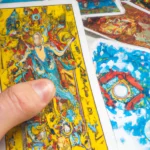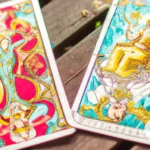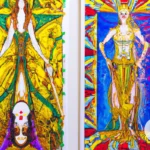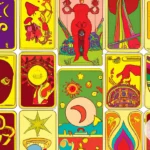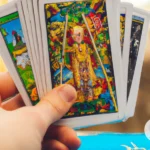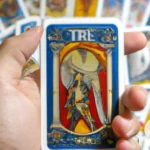The Marseille Tarot Deck: A Brief Introduction
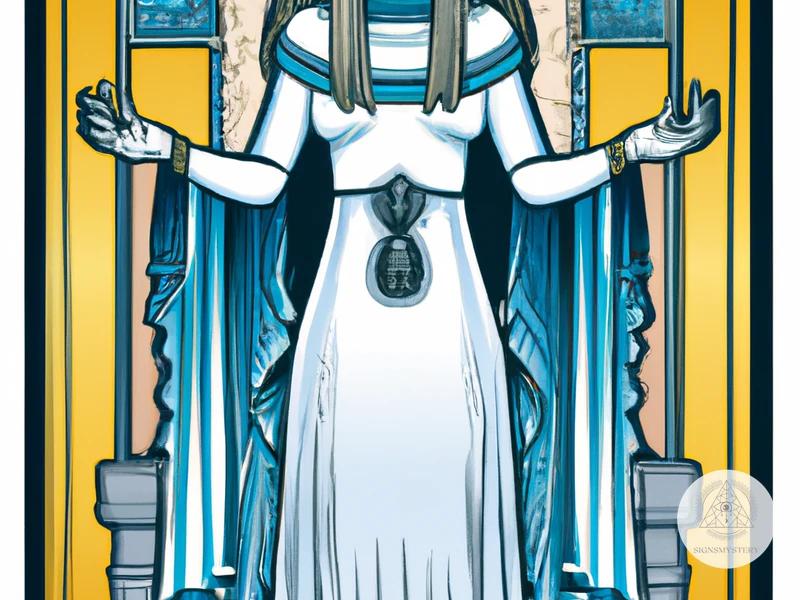
The Marseille Tarot deck is one of the most famous and revered tarot decks in the world. Its name is derived from the city of Marseille, France where it was first introduced several centuries ago. What makes this deck so unique is not only its historical significance but also its simple yet striking illustrations. The Marseille Tarot deck consists of 78 cards divided into two groups: Major Arcana and Minor Arcana.
The Major Arcana consists of 22 cards, each depicting a different archetypal figure, such as The Fool, The Magician, and The Emperor. These cards hold the most significance in any tarot reading and can represent major life events or themes.
The Minor Arcana is divided into four suits – Swords, Cups, Coins, and Wands – each containing 14 cards. These cards represent everyday situations and events that we encounter in our lives, such as love, money, work, and communication.
What sets the Marseille Tarot deck apart from other tarot decks is its simplicity. The illustrations are primarily black and white and include only the most basic symbols and elemental cues. This can create a challenge for those learning to read the tarot but can also lead to more profound and personal interpretations.
The Marseille Tarot deck is a classic and legendary tarot deck that has stood the test of time. While many modern decks contain intricate artwork and updated symbolism, the Marseille Tarot deck remains a staple for tarot enthusiasts and beginners alike. If you are interested in learning about other tarot decks, check out our article on 10 Tarot Decks to Know.
The Origins of the Marseille Tarot Deck
The origins of the Marseille Tarot Deck are shrouded in mystery and speculation. But one thing is certain – this deck has captivated the hearts and minds of tarot enthusiasts for centuries. Unlike other popular tarot decks such as the Rider-Waite or Thoth Tarot, the Marseille Tarot Deck has a certain rawness and simplicity that appeals to many readers. Its iconic, hand-drawn illustrations feature a range of curious symbols and archetypes that continue to fascinate and intrigue readers all over the world. So, let’s delve deeper into the intriguing history of the Marseille Tarot Deck and discover how it all began.
The History of Tarot
The history of tarot is shrouded in mystery and intrigue, with many different hypotheses surrounding its origins. Some believe that the tarot originated in ancient Egypt, while others claim it comes from the gypsies of Eastern Europe. However, the most widely accepted theory is that tarot cards were first used in Italy during the early 15th century.
The First Tarot Decks
The earliest known tarot decks were hand-painted and highly prized possessions, created for wealthy patrons during the Italian Renaissance. The Visconti-Sforza Tarot, created in the mid-15th century, is still considered one of the most beautiful surviving examples of early tarot art. In the years that followed, tarot cards became increasingly popular throughout Europe as a tool for divination and self-discovery.
The Invincible Marseille Tarot Deck
However, it was not until the 18th century that the Marseille tarot deck emerged as the most dominant and recognizable form of tarot. Named for the French city where it was produced, the Marseille tarot quickly became famous for its elegance and simplicity. Today, the Marseille tarot is still widely used among tarot enthusiasts, and its influence can be seen in many other tarot decks, such as the Rider-Waite Tarot and the Thoth Tarot.
To learn more about tarot decks that are popular with readers today, check out our articles on the Shadowscapes Tarot Deck, the Wild Unknown Tarot Art Style, the Nature Druid Tarot, and the Faeries Oracle Deck.
The First Tarot Decks
In the world of tarot, the first recorded tarot deck was created in the mid-15th century in northern Italy. However, the history of tarot dates back even further: the origin of tarot’s symbolism and iconography remains somewhat shrouded in mystery. Some believe that tarot cards evolved from a combination of Egyptian hieroglyphs, Kabbalistic principles, and the archetypes depicted in medieval Italian art.
The earliest known tarot decks were highly ornate and not intended for divination purposes. Instead, they were used to play a type of card game similar to bridge. It was not until the 18th century that French occultist Antoine Court de Gebelin popularized the idea of tarot as a tool for divination and spiritual reflection. His ideas inspired the creation of the first occult tarot decks, which featured mystical symbolism and imagery. One such deck was the Etteilla Tarot, named after its creator, Jean-Baptiste Alliette. The Etteilla Tarot was the first tarot deck to be specifically designed for divination purposes.
Another early tarot deck was the Tarot of Marseille, which was created in the 18th century in France. This deck is known for its simple design and its focus on the major arcana, or trump cards, which are believed to hold the most significant spiritual and symbolic meaning in a tarot deck. Other notable tarot decks that have emerged in more recent times include the Rider-Waite Tarot, which revolutionized tarot’s symbolism and is still widely used today, the Thoth Tarot, which was created by influential occultist Aleister Crowley, and the Illuminati Tarot, which utilizes ancient symbolism and imagery to explore esoteric concepts. There are many unique and modern tarot decks that cater to specific interests, such as the Mythical Creatures Tarot, the Shadowscape Tarot Deck, the Wild Unknown Tarot with its distinctive artistic style, the Nature Druid Tarot, and the Faeries’ Oracle Deck.
The Invincible Marseille Tarot Deck
The Marseille Tarot Deck is deemed invincible for its simplistic yet powerful style that sets it apart from other tarot decks. The deck’s popularity continues to this day, centuries after its creation. It is known for its black outlines and bold primary colors used to signify the different symbols in the cards. The Marseille Tarot Deck’s classic design has also served as an inspiration for many other tarot decks that followed.
The Marseille Tarot’s simplicity and its emphasis on symbolism over illustration make it perfect for reading without distractions. The deck’s clear, bare-bones design helps with personal interpretation allowing the reader to focus on innate feelings and intuition. The deck’s timeless quality has seen it through multiple artistic periods, including Rococo and Art Deco, all while remaining unaltered.
Many tarot enthusiasts consider the Marseille Tarot Deck a “must-have” for their collections. Other decks may have replaced the Marseille Tarot in popularity, but none can claim to have its enduring charm and impact. It remains a classic tarot deck that helped establish Tarot reading as an important tool for self-discovery and spiritual reflection.
The Marseille Tarot Deck’s reputation as the quintessential tarot deck is well-deserved. It is the cornerstone of Tarot, and its influence is evident in many of the contemporary tarot decks available today. The Marseille Tarot remains a powerful and reliable instrument for people looking to delve into themselves, find self-awareness, and seek answers to questions.
The Iconic Marseille Tarot Deck: Symbolism and Significance
![]()
When it comes to tarot, the Marseille Tarot Deck is undoubtedly one of the most iconic and influential decks in the history of divination. The origins of this deck can be traced back to centuries ago, and even after all these years, it continues to captivate and inspire people all over the world. The Marseille Tarot Deck is not just a deck of cards, but a treasure trove of symbolism and significance that truly sets it apart from other popular tarot decks like the Rider-Waite Tarot, Thoth Tarot Deck, Illuminati Tarot, Mythical Creatures Tarot, Shadowscapes Tarot Deck, Wild Unknown Tarot, Nature Druid Tarot, and Faeries Oracle Deck. So, let’s take a closer look at the beautiful mysteries that this historic and enigmatic deck holds within its cards.
The Major Arcana Cards
The Major Arcana Cards are the twenty-two trump cards of the Marseille Tarot Deck. These cards represent the significant events or experiences in one’s life journey that shape and define one’s character.
Each card in the Major Arcana has a unique meaning and symbolism that can be interpreted in many ways. Here is a table of the Major Arcana cards and their basic meanings:
| Card | Meaning |
|---|---|
| The Fool | New beginnings, naïveté, spontaneity, taking risks |
| The Magician | Creativity, power, manifestation, self-confidence |
| The High Priestess | Intuition, secrets, mystery, spirituality |
| The Empress | Fertility, beauty, abundance, motherhood, nurturing |
| The Emperor | Authority, stability, structure, fatherhood, leadership |
| The Hierophant | Tradition, guidance, conformity, religious beliefs, spirituality |
| The Lovers | Love, passion, harmony, partnership, choices |
| The Chariot | Willpower, success, determination, control, travel |
| Strength | Inner strength, courage, perseverance, self-mastery |
| The Hermit | Solitude, introspection, wisdom, withdrawal |
| Wheel of Fortune | Change, destiny, cycles, luck, unexpected events |
| Justice | Equality, balance, law, unbiased judgment, responsibility |
| The Hanged Man | Surrender, sacrifice, suspension, letting go, new perspective |
| Death | Endings, transformation, transition, change, regeneration |
| Temperance | Moderation, harmony, balance, alchemy, patience |
| The Devil | Materialism, addiction, bondage, temptation, self-destructive behavior |
| The Tower | Chaos, upheaval, crisis, sudden change, destruction |
| The Star | Hope, inspiration, guidance, imagination, faith |
| The Moon | Illusion, self-deception, anxiety, cycles, feminine energy |
| The Sun | Optimism, vitality, success, warmth, masculinity |
| Judgment | Rebirth, renewal, awakening, redemption, judgment |
| The World | Completion, integration, accomplishment, travel, fulfillment |
Each Marseille Tarot deck has its own unique interpretation and symbolism of the Major Arcana cards. It is recommended to explore various decks, such as the Rider-Waite Tarot Evolution, the Discover the Meaning of the Thoth Tarot Deck, the Illuminati Tarot Symbolism, the Mythical Creatures Tarot, the Shadowscapes Tarot Deck, the Wild Unknown Tarot Art Style, the Nature Druid Tarot, and the Faeries Oracle Deck, to understand the depth and complexity of the Marseille Tarot.
The Minor Arcana Cards
The Minor Arcana cards of the Marseille Tarot Deck are divided into four suits: Wands, Cups, Swords, and Coins. Each suit consists of 14 cards, with 10 numbered cards and 4 court cards. The numbered cards each display a number of suit symbols, while the court cards depict various individuals.
The Wands Suit: The Wands, also known as Batons or Staves, represent creativity, growth, and passion. The Ace of Wands symbolizes new beginnings, while the Ten of Wands depicts reaching the end of a journey or project. The court cards of the Wands suit are the Page, Knight, Queen, and King.
The Cups Suit: The Cups represent emotions, intuition, and relationships. The Ace of Cups symbolizes new emotional beginnings, while the Ten of Cups is a card of emotional fulfillment and happiness. The court cards in the Cups suit are the Page, Knight, Queen, and King.
The Swords Suit: The Swords symbolize intellect, communication, and conflict. The Ace of Swords represents new intellectual beginnings or clear communication, while the Ten of Swords is a card of defeat and loss. The court cards of the Swords suit are the Page, Knight, Queen, and King.
The Coins Suit: The Coins, also known as Pentacles, represent material possessions, financial stability, and health. The Ace of Coins represents new financial or material beginnings, while the Ten of Coins is a card of wealth and abundance. The court cards of the Coins suit are the Page, Knight, Queen, and King.
Compared to some other tarot decks such as the Rider-Waite Tarot Deck or the Thoth Tarot Deck, which often feature detailed illustrations on each Minor Arcana card, the Marseille Tarot Deck is known for its minimalist designs. However, the symbols on each card are still significant and can provide a lot of insight during a reading. For those who prefer more elaborate illustrations, they may find decks like the Shadowscapes Tarot Deck or the Mythical Creatures Tarot more appealing. However, the Marseille Tarot Deck’s simplicity can be an advantage in allowing the reader to focus on the symbolism and meanings of the cards.
The Court Cards
The Court Cards in the Marseille Tarot Deck depict various personalities and roles in medieval society. These cards are meant to represent different ranks, from the lowest of the low to the highest of the high. They are divided into four suits, each containing a Page, a Knight, a Queen, and a King.
The Suits of the Marseille Tarot Deck Court Cards:
| Suit | Page | Knight | Queen | King |
|---|---|---|---|---|
| Swords | The Valet de Fer (Page of Swords) | The Chevalier (Knight of Swords) | The Reine (Queen of Swords) | The Roi (King of Swords) |
| Wands | The Valet de Baton (Page of Wands) | The Chevalier (Knight of Wands) | The Reine (Queen of Wands) | The Roi (King of Wands) |
| Cups | The Valet de Coupe (Page of Cups) | The Chevalier (Knight of Cups) | The Reine (Queen of Cups) | The Roi (King of Cups) |
| Coins | The Valet de Deniers (Page of Coins) | The Chevalier (Knight of Coins) | The Reine (Queen of Coins) | The Roi (King of Coins) |
Each Court Card has its unique astrological and numerical significance, and the characteristics of each card can be interpreted in various ways to suit the context of the reading. However, unlike other Tarot decks, the Marseille Tarot Deck’s Court Cards offer fewer visual cues, making them more challenging to interpret for beginners.
The Marseille Tarot Deck’s Court Cards provide insight and guidance in readings by revealing the attitudes, personalities, and roles of individuals in the querent’s life or the querent’s own aspects. It is essential to study and interpret the Court Cards carefully to get the most out of Marseille Tarot readings.
The Marseille Tarot Deck: Unique Features
The Marseille Tarot Deck is one of the most iconic and highly recognized tarot decks in the world of divination. Its unique features set it apart from other tarot decks and make it a valuable addition to any tarot reader’s collection. Here are some of the most notable features of the Marseille Tarot Deck:
- Pips or Numerals: Unlike other tarot decks, the Marseille Tarot Deck has the pips (or numerals) of the minor arcana printed in a unique way. Instead of illustrations, the pips are represented by simple arrangements of the corresponding number of suit symbols (i.e., cups, coins, swords or wands). This feature adds a layer of interpretation and enables readers to connect directly with the numerological meanings of the cards.
- Absence of Illustrations: The Marseille Tarot Deck’s Major Arcana cards do feature illustrations, but the Minor Arcana cards do not. Instead, they only have simple arrangements of suit symbols, making them a bit more challenging to interpret, but also allowing for a clear and simple message to come through. This is a great way to learn tarot reading, as it trains the reader to connect with the meanings of the numbers and suits without relying on artwork.
- Small Size: The Marseille Tarot Deck was traditionally printed on small, non-glossy cards with no borders. This makes it unique, as most modern tarot decks are printed on larger, glossier cards. Many readers find the smaller size of the Marseille Tarot Deck easier to shuffle and handle, and appreciate the unobtrusive nature of the cards.
- Hand Drawn Art: The Marseille Tarot Deck was originally designed as a woodcut print, which gives the cards a distinctive, hand-drawn and rustic look. Some modern versions of the Marseille Tarot Deck have been created using this technique, while others opt for computer-generated illustrations. Either way, the artistic style of the Marseille Tarot is one of its most distinctive features, enriching its esoteric quality.
These unique features truly make the Marseille Tarot Deck stand out in a crowded market. While other tarot decks, such as the Rider Waite Tarot Evolution, the Discover Meaning Thoth Tarot Deck or the Illuminati Tarot Symbolism, have undergone significant changes or updates, the Marseille Tarot Deck remains steadfast in its traditional form. For those drawn to a more vintage aesthetic, the Marseille Tarot Deck is a perfect choice to explore the mystic and spiritual realm.
Decoding the Marseille Tarot Deck: Reading and Interpretation
As you hold the beautiful Marseille Tarot deck in your hands, you might be wondering how to begin reading and interpreting the mysterious symbols and archetypes that populate its cards. Fear not, for we will delve into the art of tarot reading and explore the significance of each card and its placement. Whether you are a seasoned tarot reader or a curious beginner, the Marseille Tarot deck has much to offer. And if you are looking for other tarot decks to explore, check out these fascinating options: the Rider Waite Tarot deck, the Thoth Tarot deck, the Illuminati Tarot deck, the Mythical Creatures Tarot deck, the Shadowscapes Tarot deck, the Wild Unknown Tarot deck, the Nature Druid Tarot deck, or the Faeries Oracle deck.
The Art of Tarot Reading
Tarot reading is an art that requires a great deal of skill and practice. It involves the interpretation of the symbols and images on the tarot cards to gain insight into a person’s past, present, or future. Here are some key things to keep in mind when learning the art of tarot reading:
1. Learn the meanings of the cards: The first step to becoming proficient in tarot reading is to thoroughly understand the meaning of each card in the deck. The Marseille Tarot Deck, in particular, has unique symbolism that must be understood to interpret it effectively.
2. Choose a tarot spread: A tarot spread is the arrangement of cards used for a specific reading. There are many different spreads to choose from, each with its own specific purpose. It is important to choose the appropriate spread depending on the question or issue at hand.
3. Focus on the question: Before starting the reading, take a few moments to focus your mind on the question or issue at hand. This will help you to form a clear intention and focus your intuition during the reading.
4. Connect with the cards: As you shuffle and lay out the cards, it is important to connect with them on a deeper level. This can be done through meditation, visualization, or simply taking a few deep breaths and quieting the mind.
5. Pay attention to symbolism and intuition: Tarot reading is not just about memorizing the meanings of the cards. It also involves using your intuition to interpret the symbols and imagery on the cards. Pay attention to any gut feelings or intuitive insights that come up during the reading.
6. Be mindful of the querent: The person receiving the reading, or the querent, should always be treated with respect and compassion. It is important to listen carefully to their questions and concerns and provide guidance that is supportive
Subscribe to Our Newsletter
Sign up to receive the latest news and updates.
The art of tarot reading is a powerful tool for gaining insight and guidance in our lives. With practice and a deep connection to the cards, anyone can learn to interpret the symbolism and meanings of the Marseille Tarot Deck and provide meaningful guidance to those seeking answers.
The Significance of Card Placement
When it comes to interpreting a tarot reading, the placement of the cards is just as important as the meaning of the cards themselves. Each position in a tarot spread represents a specific aspect of the querent’s life, and the card that falls in that position offers insight into that area. Understanding the significance of card placement is crucial to unlocking the deeper meaning of a tarot reading.
To illustrate the importance of card placement, let’s take a look at a classic three-card spread: past, present, and future. In this spread, the first card represents the querent’s past, the second card represents their present, and the third card represents their future. The cards should be laid out in the order they were drawn from the deck.
Card placement:
| Position: | Card: | Meaning: |
|---|---|---|
| Past | The Tower | A sudden, jarring change or upheaval |
| Present | The Sun | Joy, positivity, and success |
| Future | The Devil | Temptation, addiction, and negative influences |
In this example, the Tower in the past position suggests that the querent experienced a major shake-up or crisis that has had lasting impacts on their life. The Sun in the present position indicates that the querent is currently in a positive, successful phase, but the Devil in the future position suggests that they may soon be facing challenges related to temptation, addiction, or negative external influences.
It’s important to note that different tarot spreads will have different card positions with different meanings. For example, a five-card spread might include positions for the querent’s hopes and fears, while a ten-card Celtic Cross spread includes positions for the querent’s subconscious, past influences, and potential future outcomes. Understanding the different positions and their meanings is essential for accurate tarot readings.
The placement of tarot cards is a critical aspect of interpreting a reading. By understanding the significance of card placement, readers can gain deeper insight into the querent’s life and provide more accurate and specific guidance.
The Various Marseille Tarot Spreads
There are numerous ways to lay out the beautiful Marseille Tarot cards to achieve specific guidance and insight. These spreads allow the reader to focus on particular areas of life or concerns. Here are some of the most popular Marseille Tarot spreads:
| Spread Name | Description |
|---|---|
| The Past-Present-Future Spread | This classic three-card spread is ideal for gaining a general sense of direction or insight. It involves selecting three cards to represent your past, present, and future. The cards are interpreted based on their position and the question asked. |
| The Yes or No Spread | This spread involves asking a question that can be answered yes or no. The reader draws a single card, and if it is upright, the answer is yes. If it is reversed, then the answer is no. |
| The Celtic Cross Spread | This complex spread is one of the most popular and detailed spreads in tarot readings. It involves ten cards, which provide an in-depth view of the querent’s life, including past and future influences, fears, hopes, and relationships. The cards are laid out in a specific order, with each position representing a different aspect of the reading. |
| The Relationship Spread | This spread is ideal for those seeking guidance regarding their relationships. It involves laying out six cards, each representing a different aspect of the relationship, including the present state, the future, and potential obstacles. |
| The Career Spread | This spread is perfect for those seeking guidance regarding their careers. It involves laying out seven cards, each representing a different aspect of the querent’s professional life, including their strengths, weaknesses, future potential, and potential obstacles. |
Remember, the spread chosen depends on the question asked and the insight needed. Trust your intuition when choosing the right spread to get the most out of your Marseille Tarot reading.
The Importance of Intuition and Connection
When it comes to tarot reading, intuition and connection are essential components that can greatly influence the accuracy and effectiveness of the reading. In fact, many experienced tarot readers prioritize these aspects over memorized meanings of the cards. It is crucial to cultivate a connection with the cards and the querent in order to create a meaningful reading.
Intuition: Intuition can be thought of as a gut feeling or internal knowing that comes from within. It is not based on logic or reasoning, but rather on a deeper level of understanding. When reading tarot cards, intuition can help guide the interpretation of the cards and give insight into their meaning. It is important to trust your intuition and allow it to guide the reading, even if it may not make sense at first.
Connection: Building a connection with the tarot deck and the person receiving the reading is also an important aspect of tarot reading. This can be done through various techniques such as meditation, shuffling the cards, or simply taking a moment to connect with the energy of the querent. By establishing a connection, the tarot reader can gain a deeper understanding of the querent’s question and offer more personalized and accurate guidance.
Listening: In addition to intuition and connection, it is important for tarot readers to actively listen to the querent’s concerns and questions. By listening attentively, readers can gain a better understanding of the querent’s situation and provide more valuable insight.
Emotions: Tarot readings can often evoke strong emotions in the querent, and it is important for the reader to create a safe and supportive environment where the querent can process these emotions. This can be done by offering empathy, validation, and practical guidance.
The importance of intuition and connection cannot be overstated when it comes to tarot reading. By cultivating these qualities, tarot readers can offer more personalized and accurate guidance to their clients, and help them gain a deeper understanding of their situation.
The Marseille Tarot Deck: Dos and Don’ts of Reading
When it comes to reading the Marseille Tarot Deck, there are certain dos and don’ts that must be kept in mind to ensure accurate and meaningful interpretations. Here are some key points to keep in mind:
Do:
- Familiarize yourself with the symbolism and meanings of the cards.
- Create a comfortable and quiet space for reading.
- Shuffle the deck thoroughly while focusing on your question or intention.
- Pay attention to your intuition and the impressions you get from the cards.
- Ask open-ended questions that allow for more detailed and insightful answers.
- Be respectful and compassionate in your interpretations, avoiding judgments or prejudices.
- Take the time to meditate on the cards and their messages, allowing for deeper insights to emerge.
Don’t:
- Force interpretations or readings that don’t resonate with you or don’t make sense.
- Ask vague or leading questions that may limit the scope of the reading.
- Ignore certain cards or meanings because they don’t fit your expectations or desires.
- Rely solely on the literal meanings of the cards, without considering their nuances and context.
- Read the cards for others without their consent or without being properly trained and experienced.
- Use the Tarot as a substitute for professional advice or medical/psychological diagnosis.
By following these dos and don’ts, you will be able to approach the Marseille Tarot Deck with respect, curiosity, and sensitivity, and unlock its vast potential for self-discovery and guidance. Remember, the Tarot is a powerful tool for transformation and healing, but it requires an open and humble mind to reveal its true wisdom.
The Final Word on the Marseille Tarot Deck
After exploring the history, symbolism, and interpretation of the Marseille Tarot Deck, it is important to reflect on its final and lasting impact. The Marseille Tarot Deck has always been considered a classic and a mainstay in the world of tarot readings. Its intricate design, traditional use of symbolism, and powerful messages make it an essential tool for seasoned readers and curious newcomers alike.
One of the most fascinating aspects of the Marseille Tarot Deck is its ability to evoke different emotions and meanings depending on the person interpreting it. This is why it is essential to approach a Marseille reading with respect and open-mindedness. The art of tarot reading is more than just memorizing the meanings of the individual cards – it requires an intuitive connection with the deck and a deep understanding of the secrets it carries.
Beginner readers may feel overwhelmed by the Marseille Tarot Deck’s complexity, but with patience and practice, it can become a powerful tool for self-reflection and guidance. As with any form of divination, it is important to remember that the Marseille Tarot Deck is not a crystal ball or a magic eight ball, but a tool for personal insight and growth.
When conducting a reading with the Marseille Tarot Deck, it is important to approach the cards with respect and reverence. It is not advisable to use them for mere entertainment or to attempt manipulating the results of the reading. The tarot should be taken seriously, and only those with a genuine desire for self awareness or resolution are advisable to consult them for guidance.
Finally, it is important to recognize that the Marseille Tarot Deck is not the only tarot deck available, and that there are many variations and interpretations to explore. However, for those seeking a traditional and timeless experience, the Marseille Tarot Deck is an excellent choice.
To sum up, the Marseille Tarot Deck is a remarkable tool, steeped in history and symbolism, that has withstood the test of time. With proper guidance, the Marseille Tarot Deck has the potential to reveal deep insights, provide clarity and guidance, and offer a profound understanding of the self. Whether it is used for personal discovery or professional divination, the Marseille Tarot Deck remains a beautiful and mysterious treasure waiting to be explored.
Frequently Asked Questions
What is the Marseille Tarot Deck?
The Marseille Tarot Deck is a set of 78 cards used for divination or fortune-telling. It originated in the French city of Marseille in the 17th century and is one of the most commonly used tarot decks today.
What is the history of tarot?
The origins of tarot are unclear, but it is believed to have originated in Italy in the 14th century as a playing card game. It eventually evolved into a tool for divination and spiritual exploration.
What are the major arcana cards in the Marseille Tarot Deck?
The major arcana cards in the Marseille Tarot Deck are the 22 trump cards, including The Fool, The Magician, The High Priestess, The Empress, The Emperor, The Hierophant, The Lovers, and others.
What are the minor arcana cards in the Marseille Tarot Deck?
The minor arcana cards in the Marseille Tarot Deck are divided into four suits – Cups, Swords, Wands, and Coins – each with 14 cards, including ace through ten and four court cards, the Page, Knight, Queen, and King.
What are the court cards in the Marseille Tarot Deck?
The court cards in the Marseille Tarot Deck are the Page, Knight, Queen, and King for each of the four suits, Cups, Swords, Wands, and Coins.
What is the significance of card placement in a tarot reading?
The placement of cards in a tarot reading can offer important insights into the present, past, or future, as well as the querent’s hopes, fears, or desires. Cards in certain positions can also suggest specific outcomes, obstacles, or opportunities.
What are some common Marseille Tarot spreads?
Some common Marseille Tarot spreads include the Three-Card Spread, the Celtic Cross Spread, the Horseshoe Spread, and the Astrology Spread.
What is the importance of intuition and connection in tarot readings?
Intuition and connection are essential to successful tarot readings. A skilled reader must be able to interpret the symbolism of each card, but also remain open to their intuition and ability to connect with the querent and the energy of the question or situation.
What are some dos and don’ts of Marseille Tarot readings?
Do stay focused on the question or situation at hand, use clear and concise language, and trust your intuition. Don’t make predictions with absolute certainty, ignore negative cards or meanings, or use the tarot to manipulate or control others.
Can anyone learn to read the Marseille Tarot Deck?
Yes, anyone can learn to read the Marseille Tarot Deck with practice, patience, and dedication. However, it is important to approach tarot reading with respect, authenticity, and a willingness to learn and grow as a reader.



